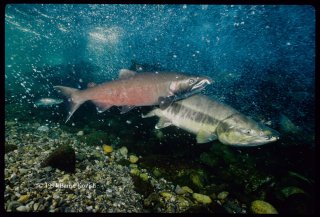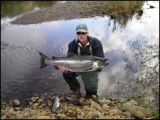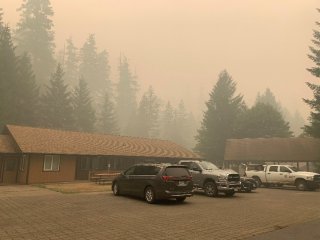EPA Research in Oregon
EPA researchers are working hard to protect communities across the nation. Learn about some of the work EPA researchers are doing in Oregon.
- Decadal Environmental Changes in Tillamook Bay
- Cold Water Refuge for Salmon and Steelhead Trout
- Can Refuges Save Salmon from a Warming Climate?
- Coastal Acidification Effects on Fisheries
- Sustaining the Natural Benefits of Tillamook Bay
- Heavy Metal Soil Contamination from Mining Activity
- Water Nitrate Contamination
- EPA Scientist Serves as Air Resource Advisor Trainee at the Lookout Fire
For more EPA work, see EPA in Oregon.
Decadal Environmental Changes in Tillamook County
EPA developed a comprehensive conservation and management plan for Tillamook Bay following designation of the bay as “an estuary of national significance” and was included in National Estuary program (NEP) in 1999. EPA's Office of Research and Development (ORD) prepared a report that: (1) assembles a case study to monitor and quantify changes in vegetation cover over the Tillamook Basin using remote sensing, the Normalized Difference Vegetation Index , an indicator of greenness; and (2) describes long term changes in greenness and climatic factors for the Tillamook basin from 1989 to 2019. Read the report in EPA's Science Inventory.
Cold Water Refuge for Salmon and Steelhead Trout

EPA researchers in ORD are working with the Lower Columbia Estuary Partnership (LCEP) to prevent further decline in the area’s iconic salmon and steelhead trout migrations. Using temperature and population data from monitoring studies by the LCEP, EPA scientists are developing fish population models that link cold water microhabitats with fish survival rates. The cooler microhabitats provide areas of refuge for the fish during their long upriver journey to spawning grounds.
Can Refuges Save Salmon from a Warming Climate?
Rising water temperatures due to climate change can impact cold-blooded migratory fish like salmon as they travel upriver to spawn. Thermal refuges, or resting areas where the temperature is cooler than in the main river, could be critical to ensuring their survival. EPA researchers are collaborating with the U.S. Geological Survey, the University of Idaho, and the Oak Ridge Institute for Science and Education to study the effects of cold-water refuges on migrating salmon in the U.S. Pacific Northwest. Read Tough Places and Safe Spaces: Can Refuges Save Salmon from a Warming Climate?
Coastal Acidification Effects on Fisheries

Increasing acidification of offshore ocean waters is threatening recreational and commercial fisheries. ORD is collaborating with Tillamook Estuaries Partnership to make real-time water quality data available to the local community including the shellfish industry. ORD scientists were invited by Oregon Department of Environmental Quality (DEQ) to be members of the Ocean Acidification and Hypoxia Technical Workgroup. As part of the team, ORD is providing technical expertise and developing an approach for parsing land- vs ocean-based acidification impacts in estuarine habitats of Oregon. This research will provide state agencies with tools to reduce the causes and effects of acidification in Pacific Northwest estuaries, helping protect a vital environmental and economic resource for coastal communities.
Sustaining the Natural Benefits of Tillamook Bay

Much of the local economy surrounding the Tillamook Bay estuary is provided by the coastal ecosystem. EPA researchers are doing work to support environmental planning that balances the sustained health of the estuary with other benefits and priorities, such as the local economy.
Heavy Metal Soil Contamination from Mining Activity
Past mining activities have left a legacy of soil and mining residues contaminated with heavy metals. Of special concern is the Formosa Mine Superfund site in south-central Oregon. ORD, Region 10 and the U.S. Department of Agriculture’s Agriculture Research Service partnered to develop new techniques to assist in this cleanup. The new techniques use soil amendments that adjust the pH, absorb heavy metals, and provide nutrients essential for plant establishment and growth. Results showed that the improved conditions over time will improve soil health and prevent flow of heavy metals downstream from these mine sites.
Water Nitrate Contamination

Groundwater nitrate contamination affects thousands of households in Oregon, especially those that obtain drinking water from domestic wells. Since 2012, ORD joined a partnership with commercial farmers, Oregon Department of Agriculture, Oregon Department of Environmental Quality and soil and water conservation districts to assess the current state of groundwater in the Southern Willamette Valley. They are evaluating best practices in fertilizer management. ORD scientists have made significant contributions to the monitoring program in the southern Willamette Valley Groundwater Management Area.
EPA Scientist Serves as Air Resource Advisor Trainee at the Lookout Fire

The U.S. Forest Service-led Interagency Wildland Fire Air Quality Response Program trains air resource advisors (ARAs) to serve on wildfire incident management teams. EPA researcher Amara Holder was deployed as an ARA trainee to the Lookout Fire in Oregon’s Willamette National Forest. Read EPA Scientist Serves as Air Resource Advisor Trainee at the Lookout Fire
